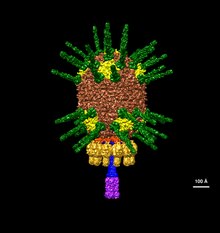| Bacillus virus Φ29 | |
|---|---|

| |
| An illustration of Φ29's head based on electron microscopy data EMDB-2162 | |
| Virus classification | |
| (unranked): | Virus |
| Realm: | Duplodnaviria |
| Kingdom: | Heunggongvirae |
| Phylum: | Uroviricota |
| Class: | Caudoviricetes |
| Order: | Caudovirales |
| Family: | Salasmaviridae |
| Genus: | Salasvirus |
| Species: | Bacillus virus Φ29
|

Bacillus virus Φ29 (bacteriophage Φ29) is a double-stranded DNA (dsDNA) bacteriophage with a prolate icosahedral head and a short tail that belongs to the genus Salasvirus, order Caudovirales, and family Salasmaviridae.[2][3] They are in the same order as phages PZA, Φ15, BS32, B103, M2Y (M2), Nf, and GA-1.[4][5] First discovered in 1965, the Φ29 phage is the smallest Bacillus phage isolated to date and is among the smallest known dsDNA phages.[2][3]
Φ29 has a unique DNA packaging motor structure that employs prohead packaging RNA (pRNA) to guide the translocation of the phage genome during replication. This novel structure system has inspired ongoing research in nanotechnology, drug delivery, and therapeutics.[6][7][8][9]
In nature, the Φ29 phage infects Bacillus subtilis, a species of gram-positive, endospore-forming bacteria that is found in soil, as well as the gastrointestinal tracts of various marine and terrestrial organisms, including human beings.[10]
- ^ Padilla-Sanchez, Victor (2021-07-17), Bacteriophage Φ29 structural model at atomic resolution, doi:10.5281/zenodo.5111609, retrieved 2021-07-17
- ^ a b Cite error: The named reference
:4was invoked but never defined (see the help page). - ^ a b Ackermann, Hans-W. (1998). "Tailed Bacteriophages: The Order Caudovirales". Advances in Virus Research. 51: 135–201. doi:10.1016/S0065-3527(08)60785-X. ISBN 978-0-12-039851-5. ISSN 0065-3527. PMC 7173057. PMID 9891587.
- ^ Bacteriophage : genetics and molecular biology. Stephen Mc Grath, Douwe van Sinderen. Norfolk, UK: Caister Academic Press. 2007. ISBN 978-1-904455-14-1. OCLC 86168751.
{{cite book}}: CS1 maint: others (link) - ^ Camacho, Ana; Jimenez, Fernando; Torre, Javier; Carrascosa, Jose L.; Mellado, Rafael P.; Vinuela, Eladio; Salas, Margarita; Vasquez, Cesar (February 1977). "Assembly of Bacillus subtilis Phage Phi29. 1. Mutants in the Cistrons Coding for the Structural Proteins". European Journal of Biochemistry. 73 (1): 39–55. doi:10.1111/j.1432-1033.1977.tb11290.x. ISSN 0014-2956. PMID 402269.
- ^ Cite error: The named reference
:2was invoked but never defined (see the help page). - ^ Cite error: The named reference
:7was invoked but never defined (see the help page). - ^ Cite error: The named reference
:8was invoked but never defined (see the help page). - ^ Cite error: The named reference
:9was invoked but never defined (see the help page). - ^ Errington, Jeffery; van der Aart, Lizah T (2020-05-11). "Microbe Profile: Bacillus subtilis: model organism for cellular development, and industrial workhorse". Microbiology. 166 (5): 425–427. doi:10.1099/mic.0.000922. ISSN 1350-0872. PMC 7376258. PMID 32391747.